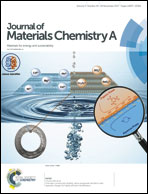Cobalt-doping in Cu2SnS3: enhanced thermoelectric performance by synergy of phase transition and band structure modification†
Abstract
Mohite-type ternary sulfide Cu2SnS3, which has been intensively studied in the photovoltaic field, has recently attracted much attention as an outstanding p-type eco-friendly thermoelectric material. In the present work, significant synergistic effects of d-orbital-unfilled transition metal (Co) doping on the crystal structure and electrical/thermal properties of Cu2SnS3 are reported. Crystal structure evolution with Co doping, involving not only monoclinic to cubic and tetragonal transitions but also the formation of a hierarchical architecture (Cu–S nano-precipitates, metal and S vacancies, and even nano-scaled stacking faults), is related to bond softening and intensified phonon scattering. Thus, an ultralow lattice thermal conductivity of 0.90 W m−1 K−1 at 323 K to 0.33 W m−1 K−1 at 723 K was obtained. Moreover, an increased effective mass is derived from the contribution of the Co 3d states to the inherent Cu 3d and S 3p states in the valence band, leading to a remarkable power factor (0.94 mW m−1 K−2, x = 0.20 at 723 K) with optimal doping. As a result, the high ZT of ∼0.85 at 723 K elevates the modified Cu2SnS3 to the level of state-of-the-art mid-temperature eco-friendly sulfide thermoelectric materials.



 Please wait while we load your content...
Please wait while we load your content...